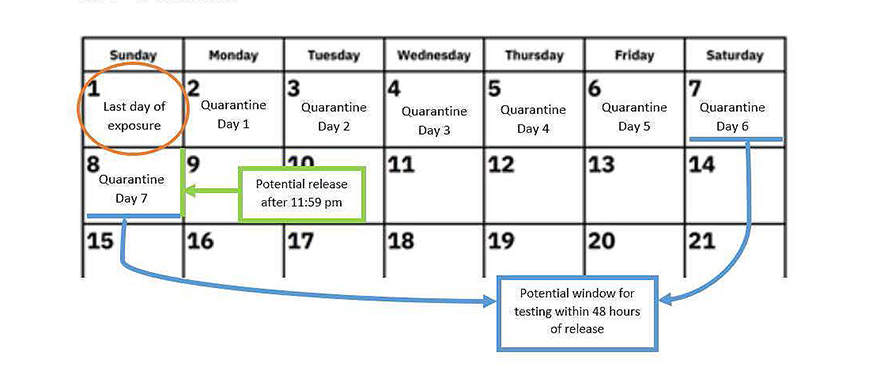December 13, 2021
Dear BKW Families:
The Albany County Department of Health (ACDOH), working with school districts in our region, has developed a test to return protocol for students and staff who have been quarantined due to exposure to COVID-19.
The department developed this policy in response to concern about excessive time spent in quarantine by students or staff who remain healthy throughout the quarantine period. By adopting a test to return policy for our schools, asymptomatic close contacts who have been quarantined may be tested with a rapid antigen test or a PCR test on day six (6), and if the result is negative, may return to school or work following day eight (8), rather than completing the 10-day quarantine period. Testing may be done at a doctor’s office or urgent care facility. BKW will offer PCR testing free of charge.
The district offers the test and processing at no charge. Arrangements can be made by contacting the school nurse. Students must be registered through Quadrant (https://app.clarifi-covid-19.com/).
The details of the test to return protocol, per the ACDOH, follow below. Thank you for your cooperation and support as we implement this new protocol for the benefit of our students, staff and community.
Sincerely,
Timothy Mundell, Ed.D.
Superintendent of Schools
7 Day Test Out of Quarantine in the Pre-K-12 School Setting – ACDOH
Quarantine is an effective tool for separating an exposed individual from others to prevent spread before the person knows they have the virus, but quarantine can be burdensome to individuals, families, schools, businesses, and communities. The incubation period of COVID-19 is 2-14 days after exposure, but the risk of becoming ill is not the same every day. Any quarantine shorter than 14 days carries a risk of continuing the spread of disease. CDC evaluated the risk of continued spread versus the benefits of reducing quarantine burden and provided options for reducing the length of quarantine.
When local circumstances and resources permit and when diagnostic testing resources are sufficient and available, CDC has indicated that a reduced quarantine period of 7 full days is an acceptable alternative if certain criteria are met. ACDOH requires the following to be considered for early release from quarantine:
1. Appropriately Timed Negative Viral Test
A negative COVID-19 viral test result from a diagnostic specimen is required. Viral tests include both antigen tests and nucleic acid amplification tests (NAAT), which include but are not limited to PCR tests. These tests can be administered in pharmacies, healthcare provider offices, and schools. In schools that have contracted with ACDOH for Quadrant testing, this test can be utilized. Abbott BinaxNOW antigen tests are also acceptable when administered by the school. At-home tests are not eligible for this protocol.
- The specimen must be collected no sooner than the morning of Day 6 of quarantine to stay within 48 hours of the time of planned quarantine discontinuation (after 11:59 p.m. on Day 7).
- The laboratory report must include the name of the laboratory, name of the individual tested and their date of birth, the date the specimen was collected, and the result of the viral test.
- Quarantine cannot be discontinued earlier than after Day 7. Day 6 of quarantine is defined as the sixth day after an individual’s last documented close contact exposure to an individual infectious with COVID-19 (“last exposure”). In the example below, if an individual’s last exposure took place on the 1st of the month, the sixth day of quarantine would be on the 7th. If a specimen collected that day tested negative for COVID-19, the individual could potentially be released from quarantine after 11:59 PM on the 8th of the month.

2. The individual under quarantine has not developed any signs or symptoms of COVID-19 since their last exposure, including the entirety of quarantine up to the time at which quarantine is discontinued.
People with COVID-19 have had a wide range of symptoms reported ranging from mild symptoms to severe illness. Symptoms may appear 2-14 days after exposure to the virus. Anyone can have mild to severe symptoms. People with these symptoms may have COVID-19:
- Fever or chills
- Cough
- Shortness of breath or difficulty breathing
- Fatigue
- Muscle or body aches
- Headache
- New loss of taste or smell
- Sore throat
- Congestion or runny nose
- Nausea or vomiting
- Diarrhea
3. The individual agrees to maintain continued vigilance against COVID-19 by adhering to the following conditions upon early release from quarantine and through Day 14 following their last exposure.
Masking: The individual must wear a mask over the nose and mouth in the presence of other people, whether indoors or outdoors, except when eating or if the individual is <2 years old or has a condition for which a mask is not recommended (e.g., compromised breathing, inability to remove the mask).
Symptom Monitoring: The individual must remain alert for COVID-19 symptoms described above. In a true medical emergency, the individual should first call 911. If any symptoms develop, the individual must immediately self-isolate and seek testing. If the result is positive, the individual will remain isolated or 10 days after symptom onset as a case. If the result is negative, the individual should remain in quarantine for 14 days after the last exposure.
Social Distancing: The individual should stay at least 6 feet from other people (3ft as appropriate in a preK-12 school setting); avoid crowds, poorly ventilated spaces, and public transportation, ridesharing, or taxis. When indoors, the individual should ensure adequate indoor ventilation whenever possible by opening windows and doors.
Personal hygiene and environmental cleaning: The individual should wash their hands often with soap and water for at least 20 seconds (or use hand sanitizer that contains at least 60% alcohol), especially after using the restroom, before preparing food, and after blowing your nose, coughing, or sneezing. The individual should also clean and disinfect high touch surfaces frequently.

You must be logged in to post a comment.